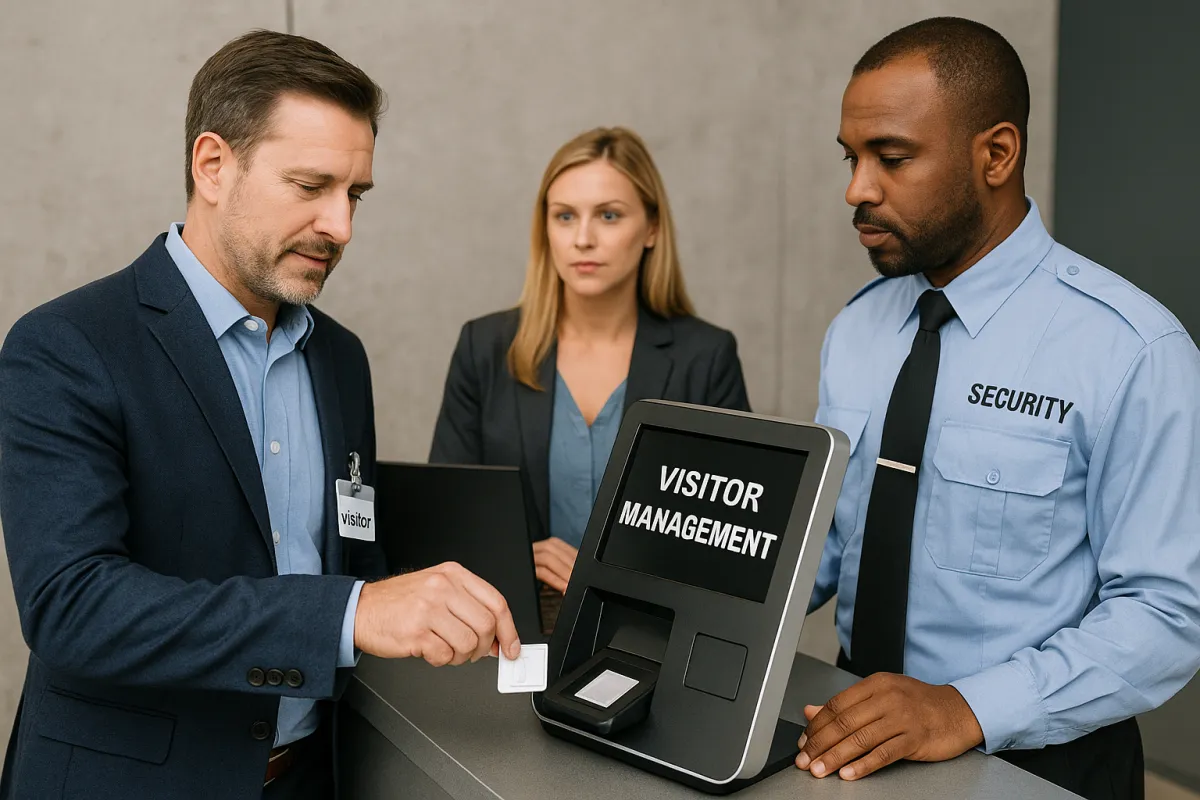Blog & News

Visitor Management: Securing Every Welcome
Visitor Management: Securing Every Welcome
Every organization—from corporate campuses to manufacturing plants, schools to healthcare facilities—welcomes guests. But with each visitor comes potential risk: unauthorized entry, data breaches, safety hazards, or logistical chaos. A robust visitor management program not only streamlines check-in and check-out but also strengthens security, ensures compliance, and enhances the guest experience.
1. Why Visitor Management Matters
Protecting People and Property
Uncontrolled visitor access can lead to theft, vandalism, workplace violence, or accidental injuries. A formalized program ensures you know who is on-site, where they are, and why they’re there—critical for both prevention and post-incident investigations.
Enhancing the Visitor Experience
Long lines, confusing signage, and repeated ID scans frustrate guests. Streamlined processes and courteous staff create a positive first impression and reflect well on your brand.
Compliance & Liability Reduction
Healthcare facilities must follow HIPAA guidelines for protected health information; financial institutions adhere to PCI DSS controls around payment card access; educational institutions comply with FERPA for student privacy. Proper visitor logs and controlled access reduce regulatory fines and legal exposure.
Efficient Operations
Automating badge printing, host notifications, and escort assignments frees up reception and security teams to focus on high-value tasks, boosting productivity.
2. Core Components of a Visitor Management Program
An effective program integrates five key elements:
Policy & Procedures: Written standards defining who qualifies as a visitor, ID requirements, escort rules, and acceptable conduct.
Workflows & Check-In: Step-by-step processes—from pre-registration to badge issuance and host notifications.
Credentialing & Access Control: Physical badges, RFID cards, or mobile credentials that enforce zone permissions.
Data Management & Privacy: Secure storage, retention policies, and compliance with GDPR or CCPA when handling personal data.
Emergency Protocols: Evacuation lists, muster points, and real-time headcounts to ensure no one is left behind.
3. Designing an Effective Check-In Workflow
Pre-Registration & Invitations
Host-Driven Registration: Employees send email invitations with unique QR codes (e.g., via Microsoft Outlook integration).
Self-Registration Portals: Public-facing forms that screen visitors against blocklists or watchlists (e.g., via an API to a government database).
Welcome Kiosk or Reception Desk
ID Scanning: Scan government-issued IDs to auto-populate visitor profiles.
Photo Capture: Snap a photo for badge verification, aiding later investigations.
Badge Printing: Print custom badges showing name, host, photo, and permitted zones.
Host Notification
Automated Alerts: Send SMS or email notifications to hosts the instant their guest checks in.
Dashboard Views: Real-time lists of upcoming and checked-in visitors visible to reception and security.
Escort vs. Unescorted Access
Define which visitor categories need an escort—contractors, minors, or those without background checks—versus those allowed unescorted movement.
4. Credentialing and Access Control
Badge Design & Features
Color-Coding: Visually distinguish between “General Visitor,” “Contractor,” “VIP,” or “Media.”
Time-Based Expiry: RFID or barcode that automatically deactivates after the allotted visit window.
Zone Indicators: Icons or text denoting areas where the badge is valid.
Integration with Physical Controls
Turnstiles & Mantraps: Prevent tailgating at entry points.
Elevator Floor Control: Limit floor access based on visitor clearance.
Parking Gate Integration: Link temporary access passes to visitor check-in records.
Identity Verification Enhancements
For high-security locations, implement multi-factor authentication—combining badge scans with OTPs sent to mobile devices or biometric scans.
5. Data Privacy & Record-Keeping
Data Minimization
Collect only what is necessary—visitor name, organization, host, photo, and timestamps—to meet security and regulatory needs.
Secure Storage & Retention
Encryption: Protect visitor data both at rest and in transit (e.g., AES-256 encryption).
Retention Policies: Automatically purge records after 30–90 days, or longer for regulated industries.
Automated Deletion: Systems that enforce retention schedules without manual intervention.
Access Controls & Audit Trails
Limit access to visitor records, maintain detailed logs of who views or exports data, and regularly review these logs for anomalies.
6. Technology Platforms and Integrations
Cloud vs. On-Premises Solutions
Cloud-Hosted: Rapid deployment, automatic software updates, and scalable storage—ideal for multi-location organizations.
On-Premises: Greater control over data, preferred by government or highly regulated sectors.
Key Integrations
Access Control Systems: Sync with HID, Lenel, or Honeywell for instant permission enforcement.
Identity Providers: Integrate with Azure AD or Okta for seamless SSO and temporary credential issuance.
Video Surveillance: Link badge scans to CCTV footage—allowing instant lookup of entry events.
Emergency Notification Systems: Automate muster lists and evacuation alerts via Everbridge or Rave Mobile Safety.
Mobile & Self-Service Options
Mobile Check-In Apps: Visitors scan a QR code to complete e-forms on their own device and receive a digital badge.
Tablet Kiosks: ADA-compliant touchscreen interfaces supporting multiple languages.
7. Compliance with Legal & Industry Standards
Healthcare (HIPAA)
Ensure visitor logs do not expose Protected Health Information (PHI). Train staff on escort policies in clinical areas.
Finance (PCI DSS)
Restrict access to payment areas and data centers. Maintain logs of all interactions with payment terminals.
Education (FERPA & Clery Act)
Campus visitor logs must balance student privacy with safety; implement special protocols for volunteers and minors.
Government & Defense
Often require background checks and continuous escorts; integrate with CAC/PIV card readers and local clearance databases.
8. Emergency & Evacuation Protocols
Real-Time Headcount Reports
Muster Lists: Automatically generated from current check-in records.
Mobile Alerts: SMS or app-based notifications to registered visitors in case of evacuation.
Evacuation Procedures
Designated Assembly Points: Clearly marked and communicated during check-in.
Assisted Evacuation: Pre-assign escorts for visitors requiring aid—e.g., wheelchair users.
Sweep Protocols: Security teams verify no one remains behind.
Post-Incident Documentation
Include visitor logs in incident reports—timestamps, locations, and evacuation confirmations—to support after-action reviews.
9. Measuring Success: KPIs and Continuous Improvement
Key Performance Indicators
Average Check-In Time: Aim for under 90 seconds per visitor.
Host Notification Delay: Target under 30 seconds.
Compliance Rate: Percentage of escorted visitors where required.
Incident Response Time: Time to locate and assist a visitor in need.
Satisfaction Scores: On-screen or emailed surveys measuring visitor experience.
Audits & Drills
Process Audits: Mystery visitor tests weekly to identify procedural gaps.
System Health Checks: Monitor kiosk uptime, badge printer status, and integration logs.
Evacuation Drills: Quarterly tests to verify accuracy of muster reporting and speed of egress.
Feedback Loops
Gather insights from receptionists, security teams, and visitors to refine workflows, update training, and enhance system usability.
10. Future Trends in Visitor Management
Biometric Onboarding: Facial recognition or fingerprint scans to expedite check-in with minimal touchpoints.
AI-Driven Watchlists: Automated screening against internal and external threat databases for higher-risk environments.
Blockchain Audit Logs: Immutable visitor records for forensic and compliance purposes.
Contactless Entry: NFC badge or mobile credentialing to improve hygiene and efficiency—critical post-pandemic.
Integrated Workplace Experience Apps: Combining visitor management with room booking, desk reservations, and cafeteria payments in one platform.
Adopting these innovations positions your organization at the forefront of secure, seamless visitor experiences.
11. How Steel Bison Security Can Help
At Steel Bison Security, we offer turnkey visitor management solutions:
Policy & Workflow Design: SOPs customized to your industry and facility layout.
Technology Selection & Integration: From cloud kiosks to biometric scanners.
Staff Training & Support: Comprehensive instruction for receptionists, security guards, and IT teams.
Ongoing Monitoring & Maintenance: Proactive system health checks and software updates.
Emergency Preparedness: Built-in muster reporting and evacuation coordination.
Learn more on our services page or schedule a consultation via our contact page.
12. Conclusion
A robust visitor management program is the cornerstone of a secure, efficient, and welcoming organization. By combining clear policies, streamlined workflows, advanced technology, and continuous refinement, you protect your people and assets while delivering a positive guest experience. Whether you operate a corporate campus, healthcare facility, or public venue, partner with Steel Bison Security to implement best-in-class visitor management that meets your operational, security, and compliance goals.
Elevate your visitor management—contact Steel Bison Security today.

EMAIL ADDRESS
OFFICE NUMBER
OFFICE ADRESS
(WA) 11900 NE First St STE 3066, Bellevue, Wa 98005
(WY) 30 N. Gould St STE R, Sheridan, Wy 82801
Copyright 2024 Steel Bison Security Services
